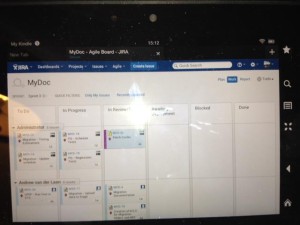For most of us, working remotely involves a computing device, a smartphone, and a solid Internet connection.
But for technical project manager Astrid Byro, the requirements are a little more complex.

This April, Astrid will be working from the trail up to Mount Everest Base Camp! Her trek aims to raise money for a fantastic student computer programming initiative at the National Museum of Computing in the UK; scroll down for more info.
As a technical project manager contracted by GE Healthcare, Astrid oversees a team of eight software developers following an agile development process within a classic waterfall approach. She also acts as a liaison between technical and business development teams within GE Healthcare.
And she’s not letting a little 3-week hike interfere with her project’s scheduled delivery.
Equipped with an Amazon Kindle Fire, a 3G-to-Wifi convertor, a feature phone, and some power cables, Astrid can work remotely by loading Jira and Confluence on her tablet. Astrid uses Jira to get real-time updates of every issue her colleagues are working on, while Confluence lets her team brainstorm ideas with other departments without clogging their inboxes with endless email chains. Astrid said the integration of the two products saves her a lot of time as well; for example, the ability to drop Jira tickets into a Confluence page ensures her teams have “full transparency and an audit trail, as well as a self-generating knowledge base,” she said. Her managers can access Astrid’s Jira dashboard to see automatically generated progress reports.
“As long as I’m connected to the Internet, I can do my work,” she said. “On Mount Everest, this is obviously more difficult because of the lack of a consistent connection, so the biggest challenge is just knowing where I find a connection.”
Last year, Astrid trekked in the Himalayas twice to get a feel for the lay of the land. She now has a general idea of which parts of the trail will have connectivity, and which will require some more flexibility in her schedule– for instance, a detour to a bar with WiFi. For the most part Astrid will be able to convert a 3G signal to WiFi.
Astrid’s Work-From-Everest (WFE) Schedule
And the whole halfway-around-the-world-up-a-mountain thing? Not a barrier, in fact, the 5 hour, 45 min time difference between the UK and Nepa works in Astrid’s favor.
At dawn, Astrid will wake up to catch up on emails, sterilize bottles of water, and take photos. By 8:30 am local time she’ll hit the trail, and plans to get in a good seven hour hike before her team comes online in the UK. At 3:30 pm local time, she’ll receive a call from her team and run a standup meeting, during which everyone verbally goes through their tasks for the day. Afterwards, Astrid will check her Jira dashboard as often as she can to keep track her team’s accomplishments (or bottlenecks).
Astrid said she tried a few other “extreme telecommuting” setups, but found that nothing came close to the leanness that Atlassian’s On-Demand products offered.
“We tried a Powerpoint and an Excel project dashboard,” she said. “I think either of those would have worked in a classic onsite scenario, but they were not sufficient for a distributed team and we quickly got ensnared with various versions of dashboards flying around.”

Trekking to Inspire Young Programmers

There’s a wonderful, geeky cause behind Astrid’s telecommuting adventures. She’s climbing to raise money for an IT literacy program at The National Museum of Computing, in Bletchley Park in the UK. The program invites A-level students to learn how to code using old BBC microcomputers (circa the 80s!)– a much more unforgiving programming environment that doesn’t even accept basic copy/paste functions.
“The reason for using these old machines is that you’re coding closer to the metal,” she said. “You’re learning more about how computers actually work rather than using pretty interfaces.”
The museum also contains one of the world’s largest collections of computers, starting with a recreation of the Colussus, the world’s first electronic, programmable computer, dating back to World War II.
If you’d like to read more about Astrid’s trip, check out her blog ABC2EBC. You can also donate to her cause at her JustGiving page. 100% of the proceeds go to the museum.